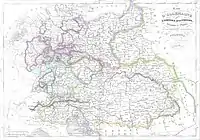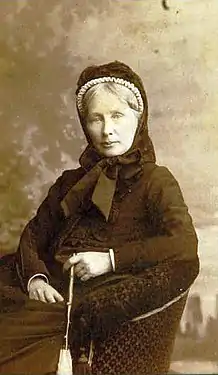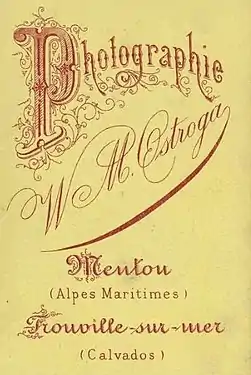Walery Mroczkowski
Walery Karłowicz Mroczkowski (April 6, 1840 – October 1, 1889) was a Polish insurgent in the 1863 January Uprising. He was arrested and imprisoned by the Prussian authorities. Upon release in 1865, he was sent into exile and travelled to Italy, Switzerland, London and finally settled in France. While in Florence he met Mikhail Bakunin and became an anarchist and a member of the latter's close circle. He is also known as a portrait photographer in France, working under the pseudonym, "Ostroga" or "Valerien Ostroga".
Walery Mroczkowski | |
|---|---|
 Walery Mroczkowski 1862 by Biedroński | |
| Born | 6 April 1840 |
| Died | 1 October 1889 (aged 49) Paris, France |
| Resting place | Menton |
| Nationality | Polish |
| Other names | "Wincenty Kamiński", "Valerien Ostroga", "Ostroga" |
| Education | Warsaw Academy of Medicine |
| Occupation | Photographer |
| Years active | 1871–1889 |
| Era | 19th century |
| Known for | January Uprising, photography |
| Movement | Anarchism |
| Children | Felix (1867–1936) and Léonie (1871–1947) Ostroga |
| Parent(s) | unknown |
| Relatives | Elisee Reclus |
Early life

Nothing is known, at present, of Mroczkowski's family background or childhood.[1] As the earliest written record, the diary of his uprising colleague Szymon Kotylla published in 1907, indicates that he was a student at the Medical Academy in Warsaw (1860–1861), he would have had access to funds for his interrupted studies and for travel to Italy for military training.[2]'[3] As a convinced patriot he went to Cuneo in Italy to attend the Polish military cadet school (1861–62), commanded by Ludwik Mierosławski in preparation for a future uprising.[4]
On his return to Poland in 1862 the National Central Committee despatched him to the Augustów Governorate, under cover of being a journalist with the nom-de-guerre "Wincenty Kamiński", to help organize military units. He was a Biebrza district commissar, local Plenipotentiary for the Rada Narodowa (National revolutionary council) and was responsible for the purchase of armaments.[5][6] The following year he took part in a series of skirmishes and in May 1863 he distinguished himself at the head of a relief party in the battle of Kazlų Rūda.[7][8]
By November 1863 he was in Eastern Prussia where he was arrested and imprisoned in Posen-West Prussia. In 1865 he was released and forced into exile.
Encounter with Anarchism

As an activist prior to his exile Mroczkowski was regarded as a democrat and an apostle of the Emancipation of serfs.[9] On a trip to Florence in 1865 he met Mikhail Bakunin who befriended him and suggested he accompany him on a trip to Naples. There he was introduced to princess Zoë Sumarokov, (born 1828). She was the estranged wife of Prince Alexei Obolensky with whom she had six children, and was living with them among revolutionaries escaped from Russia. She would become Mroczkowski's lover and later his wife and have two children with him.[10][11]
While staying on Ischia with Bakunin in 1866, Mroczkowski together with his now partner, Zoë, produced a French translation of the Revolutionary Catechism, Bakunin's founding text for the secret "international revolutionary society" they were planning.[12] Bakunin's Pet name for Mroczkowski was the affectionate diminutive, "Mrouk". In Polish "mruk" means the "grunter" or the "silent one".[13]
A Swiss interlude
In 1867, they decided to settle in Switzerland. Initially they stayed in Vevey, then in Geneva. There they met the French geographer and theorist, Élisée Reclus, whose daughter would later become the companion of the Mroczkowskis' son, Felix.[14] In 1868 having become members of the First Internationale and then of the central committee of the
League of Peace and Freedom, after the schism in the aftermath of the Berne Convention, Mroczkowski and Bakunin formed a group to oppose the ideology of Karl Marx.[15][16]
Mroczkowski was also involved in drawing up plans for the refurbishment of the villa, La Baronata perched above Lake Maggiore, a retirement retreat built for Carlo Cafiero, who initially "gave" it to Bakunin, but on discovering that his fortune was leaching away, was able to get it back.[17]
London episode
In 1869 they left Switzerland and travelled as a couple to London and for about two years moved there in revolutionary circles that included people such as Karl Marx and Walery Wroblewski[18][19]
A new career in photography
Since Prince Obolensky had forcibly abducted his children from his wife, Zoë, in 1869, her income dropped considerably. Having left Switzerland and now London, Mroczkowki and Zoë took up residence in Menton. There in 1871 Mroczkowski opened a photographic studio as "Walerian M.Ostroga", specialising in portraits. Eventually, he split his time working in Trouville-sur-Mer during the Summer and Menton in Winter. Living in two places enabled him to justify extensive travel and disguise his anarchist activities. Work as a photographer helped him keep his family – his Common-law marriage to Zoë and their two children, Félix (1867–1936) and Léonie (1871–1947). They were finally married after the death of Prince Alexei Vasilievitch, Zoe's husband, and were able to buy a villa, "les mouettes", that became "villa Ostroga".
Walery Mroczkowski/Valerien Ostroga died on 1 October 1889 in Paris and was buried in the Vieux-Château cemetery in Menton.[20][21] His children and descendants adopted the surname "Ostroga", being easier to write and pronounce in French.
Gallery
- Photos by Valerien Ostroga
 Alexandra Obolenskaya née Djakov, sister-in-law of Zoë (1879)
Alexandra Obolenskaya née Djakov, sister-in-law of Zoë (1879) Business addresses on the back of an Ostroga Cabinet card
Business addresses on the back of an Ostroga Cabinet card.jpg.webp) Paul Mirabaud (1880)
Paul Mirabaud (1880)
Bibliography
- Mroczkowski Walery (1840–1889) powstaniec 1863, emigrant. Polski Słownik Biograficzny vol. 22 p. 185
- Laskowski, Piotr. (2016) "Jedyny wybitny bakuninowiec"- Walerian Mroczkowski (1840–1889) dans Studia z Dziejów Anarchizmu (2) w Dwusetleciu Urodzin Michała Bakunina.' Red. Skrzycki, Radosław. Szczecin: Wydawnictwo Naukowe Uniwersytetu Szczecińskiego. ISBN 978-83-7972-056-9 p. 81–122.
See also
References
- Note: His birth so far north into the Russian Empire has a twofold explanation: his father had obtained work there. More likely, however, is that it was a favoured place of banishment for recalcitrant Poles. There is a justifiable presumption that his father may have been sent there for his political activism in the earlier 1831 November uprising
- Chankowski, Stanisław. (1972). Powstanie styczniowe w Augustowskiem. In the series "Prace Białostockiego Towarzystwa Naukowego", No. 17. Published Warsaw: Państwowe Wydawnictwo Naukowe (PWN). fn.90. pp. 65/67. This is a well sourced history of the January Uprising in the Augustów County. In it the author quotes the painter Szymon Kotylla and his memoire of WM. A portrait of Mroczkowski is included with his signature as, Walery M.
- photo p. 67/134
- Ecole militaire polonaise Cunéo
- Choińska, Małgorzata. (2013). Społeczeństwo miasta Tykocina w XVIII i XIX w.. Instytut Historii, Uniwersytet Białostocki. Doctoral thesis. http://repozytorium.uwb.edu.pl/jspui/bitstream/11320/1314/1/Choinska_Malgorzata_doktorat.pdf Dr. Choińska confirms Mroczkowski was using the name "Wincenty Kamiński", while active in the area, see p.102. Retrieved 1 December 2018.
- http://www.genealogia.okiem.pl/powstanies/index.php?nazwisko=Kamiński List of January Uprising insurgents, no.48473 Wincenty Kamiński
- Récits des combats Journal des débats politiques et littéraires
- genealogia.okiem
- Laskowski, Piotr. (2016) "Jedyny wybitny bakuninowiec"- Walerian Mroczkowski (1840–1889) in Studia z Dziejów Anarchizmu (2) w Dwusetleciu Urodzin Michała Bakunina. Ed. Skrzycki, Radosław. Szczecin: Wydawnictwo Naukowe Uniwersytetu Szczecińskiego. ISBN 978-83-7972-056-9 p.82 The Polish title translates as "The only and foremost follower of Bakunin"
- [http://oasis.lib.harvard.edu/oasis/deliver/~fun00006 Letters of the Obolensky family Harvard University.edu
- M.C. Rintoul, Dictionary of Real People and Places in Fiction, Routledge, 2014, page 713
- Le Catéchisme révolutionnaire atelierdecreationlibertaire
- Lettre de Bakounine archive.org Bakunin's correspondence with Mroczkowski
- Berne 1868 florian-pennec.net
- Discours de Berne in Kolokol of 1 December 1868 (p. 218)
- La Baronata James Guillaume- l'internationale
- La Baronata atelierdecreationlibertaire
- Próchnik, Adam. (1933). "Początki socjalizmu polskiego" in Księga Jubileuszowa PPS 1892–1932, edited by Krieger, A., Maliniak, J., Wasilewski, L. et Zaremba, Z. Varsovie: "Robotnik" Publications. https://sbc.org.pl/Content/84093/ii25240.pdf p. 9 1892–1932)
- L'Autre Bakounine monde-nouveau.net (cf. note p. 128-129) "The Other Bakunin"
- Acte décès archives Paris Ve (p. 29/31)
- Tombe Menton tombeauxpolonais.eu
External links
- Portrait National Museum of Warsaw (Muzeum Narodowe w Warszawie)
- "Powstanie Styczniowe w illustracjach prasy epoki" Newspaper Illustrations of the January Uprising, featuring the battle at Kozłowa Ruda, in which Mroczkowski took part and is mentioned in the text. See page 35
- Group photo with Bakunin
- Photos on Gallica BnF
- Photos Trieste Library
- Un quatrième Walery photographe Hugues Fontaine's Blog
- "Ostroga" genealogy on pierfitgeneanet
| Wikimedia Commons has media related to Valerien Ostroga. |
